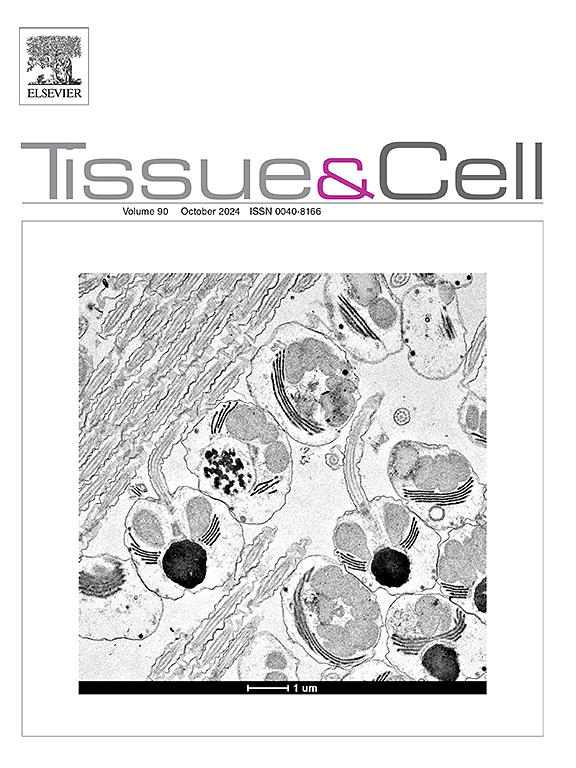Ameliorative effects of hesperidin against cyclophosphamide-induced ovarian dysfunction in the female rat model
IF 2.7
4区 生物学
Q1 ANATOMY & MORPHOLOGY
引用次数: 0
Abstract
Cyclophosphamide (CP) is a commonly used antineoplastic and immunosuppressive drug that has serious adverse effects, such as ovarian damage and infertility. The aim of this study was to find out how hesperidin (HSP), a naturally occurring flavonoid with well-established health benefits, can prevent ovarian damage brought on by CP Thirtytwo adult female albino rats were divided into four groups: control, HSP-treated, CPtreated, and CP+HSP-treated. CP administration resulted in significant hormonal imbalances, including reduced level of prolactin, estrogen, FSH, and LH and decreased body and ovarian weight. Oxidative stress markers were elevated with increased ovarian malondialdehyde (MDA) and reduced antioxidant activity. Molecular analysis showed downregulation of hypothalamic (KISS-1, KISS-1r, and GnRH), hypophyseal (GnRHr) genes, and key ovarian steroidogenic enzymes. CP also upregulated ovarian P21 and NF-κB, increased immunological expression of P53 and iNOS, and caused significant histopathological and immunohistochemical changes in ovarian tissues. HSP co-administration has alleviated many of these adverse effects, improved hormonal balance, and reduced oxidative stress. This restored gene expression, and preserved ovarian structure. These results highlight the potential of HSP as a protective agent against CP-induced ovarian damage and infertility, offering promising implications for female fertility preservation during chemotherapy.
橙皮苷对环磷酰胺诱导的雌性大鼠卵巢功能障碍的改善作用
环磷酰胺(CP)是一种常用的抗肿瘤和免疫抑制药物,具有严重的不良反应,如卵巢损伤和不孕。本研究的目的是发现橙皮苷(HSP)是一种天然存在的具有良好健康益处的类黄酮,如何预防CP引起的卵巢损伤32只成年雌性白化大鼠分为四组:对照组、HSP组、cpp组和CP+HSP组。服用CP导致显著的激素失衡,包括催乳素、雌激素、卵泡刺激素和黄体生成素水平降低,身体和卵巢重量下降。氧化应激指标随着卵巢丙二醛(MDA)的升高和抗氧化活性的降低而升高。分子分析显示,下丘脑(KISS-1、KISS-1r和GnRH)、垂体(GnRHr)基因和卵巢关键类固醇生成酶下调。CP还上调卵巢P21和NF-κB,增加P53和iNOS的免疫表达,引起卵巢组织明显的组织病理学和免疫组化变化。HSP联合用药减轻了许多这些不良反应,改善了激素平衡,减少了氧化应激。这恢复了基因表达,并保留了卵巢结构。这些结果突出了热sp作为一种保护剂的潜力,可以防止cp诱导的卵巢损伤和不孕症,为化疗期间女性生育能力的保存提供了有希望的启示。
本文章由计算机程序翻译,如有差异,请以英文原文为准。
求助全文
约1分钟内获得全文
求助全文
来源期刊

Tissue & cell
医学-解剖学与形态学
CiteScore
3.90
自引率
0.00%
发文量
234
期刊介绍:
Tissue and Cell is devoted to original research on the organization of cells, subcellular and extracellular components at all levels, including the grouping and interrelations of cells in tissues and organs. The journal encourages submission of ultrastructural studies that provide novel insights into structure, function and physiology of cells and tissues, in health and disease. Bioengineering and stem cells studies focused on the description of morphological and/or histological data are also welcomed.
Studies investigating the effect of compounds and/or substances on structure of cells and tissues are generally outside the scope of this journal. For consideration, studies should contain a clear rationale on the use of (a) given substance(s), have a compelling morphological and structural focus and present novel incremental findings from previous literature.
 求助内容:
求助内容: 应助结果提醒方式:
应助结果提醒方式:


